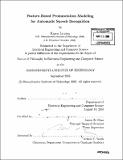| dc.contributor.advisor | James R. Glass. | en_US |
| dc.contributor.author | Livescu, Karen, 1975- | en_US |
| dc.contributor.other | Massachusetts Institute of Technology. Dept. of Electrical Engineering and Computer Science. | en_US |
| dc.date.accessioned | 2008-03-26T20:36:55Z | |
| dc.date.available | 2008-03-26T20:36:55Z | |
| dc.date.copyright | 2005 | en_US |
| dc.date.issued | 2005 | en_US |
| dc.identifier.uri | http://dspace.mit.edu/handle/1721.1/34488 | en_US |
| dc.identifier.uri | http://hdl.handle.net/1721.1/34488 | |
| dc.description | Thesis (Ph. D.)--Massachusetts Institute of Technology, Dept. of Electrical Engineering and Computer Science, 2005. | en_US |
| dc.description | Includes bibliographical references (p. 131-140). | en_US |
| dc.description.abstract | Spoken language, especially conversational speech, is characterized by great variability in word pronunciation, including many variants that differ grossly from dictionary prototypes. This is one factor in the poor performance of automatic speech recognizers on conversational speech. One approach to handling this variation consists of expanding the dictionary with phonetic substitution, insertion, and deletion rules. Common rule sets, however, typically leave many pronunciation variants unaccounted for and increase word confusability due to the coarse granularity of phone units. We present an alternative approach, in which many types of variation are explained by representing a pronunciation as multiple streams of linguistic features rather than a single stream of phones. Features may correspond to the positions of the speech articulators, such as the lips and tongue, or to acoustic or perceptual categories. By allowing for asynchrony between features and per-feature substitutions, many pronunciation changes that are difficult to account for with phone-based models become quite natural. Although it is well-known that many phenomena can be attributed to this "semi-independent evolution" of features, previous models of pronunciation variation have typically not taken advantage of this. In particular, we propose a class of feature-based pronunciation models represented as dynamic Bayesian networks (DBNs). | en_US |
| dc.description.abstract | (cont.) The DBN framework allows us to naturally represent the factorization of the state space of feature combinations into feature-specific factors, as well as providing standard algorithms for inference and parameter learning. We investigate the behavior of such a model in isolation using manually transcribed words. Compared to a phone-based baseline, the feature-based model has both higher coverage of observed pronunciations and higher recognition rate for isolated words. We also discuss the ways in which such a model can be incorporated into various types of end-to-end speech recognizers and present several examples of implemented systems, for both acoustic speech recognition and lipreading tasks. | en_US |
| dc.description.statementofresponsibility | by Karen Livescu. | en_US |
| dc.format.extent | 140 p. | en_US |
| dc.language.iso | eng | en_US |
| dc.publisher | Massachusetts Institute of Technology | en_US |
| dc.rights | M.I.T. theses are protected by
copyright. They may be viewed from this source for any purpose, but
reproduction or distribution in any format is prohibited without written
permission. See provided URL for inquiries about permission. | en_US |
| dc.rights.uri | http://dspace.mit.edu/handle/1721.1/34488 | en_US |
| dc.rights.uri | http://dspace.mit.edu/handle/1721.1/7582 | en_US |
| dc.subject | Electrical Engineering and Computer Science. | en_US |
| dc.title | Feature-based pronunciation modeling for automatic speech recognition | en_US |
| dc.type | Thesis | en_US |
| dc.description.degree | Ph.D. | en_US |
| dc.contributor.department | Massachusetts Institute of Technology. Department of Electrical Engineering and Computer Science | |
| dc.identifier.oclc | 70847032 | en_US |
